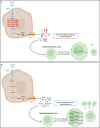Facts and Perspectives: Implications of tumor glycolysis on immunotherapy response in triple negative breast cancer
- PMID: 36703796
- PMCID: PMC9872136
- DOI: 10.3389/fonc.2022.1061789
Facts and Perspectives: Implications of tumor glycolysis on immunotherapy response in triple negative breast cancer
Abstract
Triple negative breast cancer (TNBC) is an aggressive disease that is difficult to treat and portends a poor prognosis in many patients. Recent efforts to implement immune checkpoint inhibitors into the treatment landscape of TNBC have led to improved outcomes in a subset of patients both in the early stage and metastatic settings. However, a large portion of patients with TNBC remain resistant to immune checkpoint inhibitors and have limited treatment options beyond cytotoxic chemotherapy. The interplay between the anti-tumor immune response and tumor metabolism contributes to immunotherapy response in the preclinical setting, and likely in the clinical setting as well. Specifically, tumor glycolysis and lactate production influence the tumor immune microenvironment through creation of metabolic competition with infiltrating immune cells, which impacts response to immune checkpoint blockade. In this review, we will focus on how glucose metabolism within TNBC tumors influences the response to immune checkpoint blockade and potential ways of harnessing this information to improve clinical outcomes.
Keywords: immune checkpoint inhibitor (ICI); immune microenviroment; regulatory T (Treg) cell; triple negative breast cancer (TNBC); tumor glycolysis.
Copyright © 2023 Schreier, Zappasodi, Serganova, Brown, Demaria and Andreopoulou.
Conflict of interest statement
RZ is an inventor on patent applications related to work on GITR, PD-1, and CTLA-4 (patent numbers: US20180244793A1; US10323091B2; WO2018106864A1; WO2019094352A1). RZ is a scientific advisory board member for iTEOS Belgium SA. SD has received compensation for consultancy/advisory services from Lytix Biopharma, EMD Serono, Ono Pharmaceutical, and Genentech, and research support from Lytix Biopharma and Boehringer-Ingelheim for unrelated projects. AS, IS, KB, and EA do not have any conflicts of interest to declare.
Figures


Similar articles
-
Biomarkers of Immune Checkpoint Blockade Response in Triple-Negative Breast Cancer.Curr Treat Options Oncol. 2021 Mar 20;22(5):38. doi: 10.1007/s11864-021-00833-4. Curr Treat Options Oncol. 2021. PMID: 33743085 Review.
-
Immune checkpoint inhibitors for triple-negative breast cancer: From immunological mechanisms to clinical evidence.Int Immunopharmacol. 2021 Sep;98:107876. doi: 10.1016/j.intimp.2021.107876. Epub 2021 Jun 17. Int Immunopharmacol. 2021. PMID: 34146865 Review.
-
Lactate Metabolism and Immune Modulation in Breast Cancer: A Focused Review on Triple Negative Breast Tumors.Front Oncol. 2020 Nov 26;10:598626. doi: 10.3389/fonc.2020.598626. eCollection 2020. Front Oncol. 2020. PMID: 33324565 Free PMC article. Review.
-
Immunotherapy in triple-negative breast cancer: Insights into tumor immune landscape and therapeutic opportunities.Front Mol Biosci. 2022 Aug 19;9:903065. doi: 10.3389/fmolb.2022.903065. eCollection 2022. Front Mol Biosci. 2022. PMID: 36060249 Free PMC article. Review.
-
Integrating Immunotherapy Into the Treatment Landscape for Patients With Triple-Negative Breast Cancer.Am Soc Clin Oncol Educ Book. 2022 Apr;42:1-13. doi: 10.1200/EDBK_351186. Am Soc Clin Oncol Educ Book. 2022. PMID: 35649211 Review.
Cited by
-
Dichloroacetate for Cancer Treatment: Some Facts and Many Doubts.Pharmaceuticals (Basel). 2024 Jun 6;17(6):744. doi: 10.3390/ph17060744. Pharmaceuticals (Basel). 2024. PMID: 38931411 Free PMC article. Review.
-
hsa_circ_0003596, as a novel oncogene, regulates the malignant behavior of renal cell carcinoma by modulating glycolysis.Eur J Med Res. 2023 Sep 2;28(1):315. doi: 10.1186/s40001-023-01288-z. Eur J Med Res. 2023. PMID: 37660068 Free PMC article.
-
Role, mechanisms and effects of Radix Bupleuri in anti‑breast cancer (Review).Oncol Lett. 2025 Jan 30;29(4):166. doi: 10.3892/ol.2025.14912. eCollection 2025 Apr. Oncol Lett. 2025. PMID: 39963320 Free PMC article. Review.
-
Pharmacological Mechanism of Mume Fructus in the Treatment of Triple-Negative Breast Cancer Based on Network Pharmacology.Appl Biochem Biotechnol. 2024 Nov;196(11):7974-7993. doi: 10.1007/s12010-024-04948-w. Epub 2024 Apr 26. Appl Biochem Biotechnol. 2024. PMID: 38668843
-
Haoya Wang Et Al.: Circadian Rhythm Disruption Promotes Tumor Progression Through Upregulated Glycolysis.Cancer Med. 2025 Aug;14(15):e71138. doi: 10.1002/cam4.71138. Cancer Med. 2025. PMID: 40772466 Free PMC article. Review.
References
-
- Malorni L, Shetty PB, Angelis De C, Hilsenbeck S, Rimawi MF, Elledge R, et al. . Clinical and biologic features of triple-negative breast cancers in a large cohort of patients with long-term follow-up. Breast Cancer Res Treat (2012) 136(3):795–804. doi: 10.1007/s10549-012-2315-y - DOI - PMC - PubMed
Publication types
Grants and funding
LinkOut - more resources
Full Text Sources

